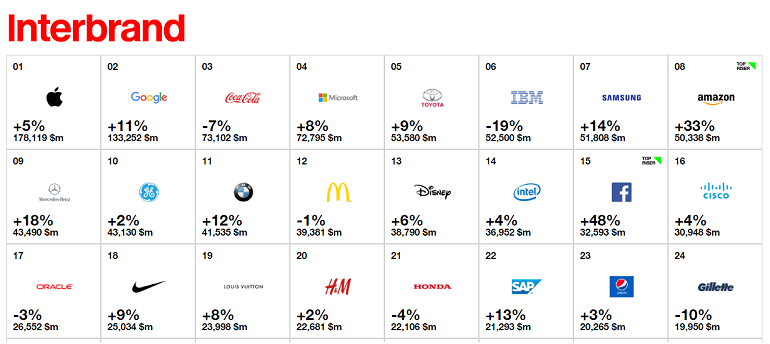
Brand is a hot topic for tech companies lately. It’s unsurprising, because tech companies are currently dominating the top brand charts. In the 2016 Interbrand survey, technology companies occupy fully half of the top 24 global brands with Apple and Google 1st and 2nd, and Facebook and Amazon the top growing brands in their report.

Why Brand Matters
Brand creates a durable competitive advantage
Strong brands are defensible moats around your product. Having a great brand means that you’ve achieved differentiation from your competitors in a way that is far more difficult than copying your feature set. However, brand can also feel intangible and challenging to measure, which makes efforts to build it hard to justify.
Brand is a source of high-quality traffic and improved conversion
From a quantitative mindset, let’s start with how brand can impact business metrics. One concrete benefit is free direct and referral traffic. Often this is also described as word-of-mouth, but for companies with established brands it shows up as direct traffic to your site. This is traffic that you don’t have to pay to acquire. In addition to this, companies with strong brands will often see higher conversion rates. With a strong brand, you can become one of the first names to come to mind in your product category. This is what marketers refer to as the consideration set, or the subset of brands that customers evaluate when they consider a purchase. A consumer example of this would be soda brands. What brands come to mind when you think of soda? Most often Coke and Pepsi are one of the first followed by a handful of other brands. Becoming part of the consideration set for your category means that inevitably you’ll be referenced and linked, which also improves quantitative factors such as domain authority, quality score and referral traffic. Thus, achieving strong brand awareness and inclusion into the consideration set translates directly into subsidizing acquisition and conversion costs.
Brand influences re-purchase and loyalty
Strong and positive brand associations can also translate into higher purchase and re-purchase rates. Have you ever debated buying something and thought, well my friend told me this product was good so even though it’s a bit more expensive I’ll go with it? Customers who have an implicit trust or belief in your brand will convert more easily and more quickly, because your brand promise facilitates decision making.
The benefits are substantial, but the challenge is that realizing the brand value is a long-term process which isn’t as quick as an AB test or feature launch. So short-term focused companies often struggle to justify long-term investments to build brand.
Three keys to building a strong technology brand
- Technology brands are built on actions and experiences, not ads
Often, consumer goods companies like P&G, Mars and Clorox come to mind as great examples of brand strategy applied. However, while many of the branding principles are shared, the toolset is very different. This is because technology brands are intimately tied to product experience. What branding isn’t is the advertisement or video that you throw up telling them what you are. Rather, it’s the summation of all of a person’s experiences with the product and the impression it evokes. One of the first words that come to mind for Google’s brand is “smart”. People do not think that Google is smart because of an ad campaign; instead, Google is smart due to its high-quality search results and how convenient it is that it tells you showtimes near you when you search movies.
Let’s consider the ways a potential or existing customer engages with your product. Here’s a list of common touch points they may have along the way:
- Online and offline advertisements
- Press, events and social media
- Marketing emails and newsletters
- Company and product website
- Product-driven email
- Mobile app experience and push notifications
- Product onboarding
- Product quality and user interface
- Sales and support interactions
While this list looks like 50/50 in terms of marketing and non-marketing channels, it’s key to think about time spent. Unlike consumer goods companies, tech customers are spending the vast majority of their brand experience inside of rich, immersive product experiences. The user experience, the voice and tone of the in-product copy, and the overall product experience are key levers to developing and reinforcing a strong brand.
When companies begin to consider their brand, they often assign someone in their organization with the task of “transforming the brand”. As you consider the brand touch points listed above, it’s clear that this individual has a daunting task: their goal is to impact the customer’s brand experience but in order to do this they have to be able to influence product, marketing, sales, support, and other teams. Companies should adopt a holistic view as they seek to build their brand.
2. Branding is about amplifying your story, not rewriting it
Don’t decide what you want to be and then make an ad campaign for it. Building a strong brand entails finding and articulating your product’s values and then polishing and amplifying those values into authentic stories. The most powerful brand moments are when companies take action and stand out. Tylenol doing an expensive product recall because customers come first. Amazon’s generous refund policies for their customers. Southwest being the last holdout for charging bag fees. MailChimp telling you to take a banana break after you send a campaign. Brand experiences are created when people notice unnecessary, extraneous, delightful experiences that don’t fit in with the rest of the industry.
A common challenge is differentiating the aspirational from the actual. It’s essential to differentiate between what you are from what what you’d like to be. This is because while it’s not impossible to change your brand over time, it’s often an evolution that doesn’t happen quickly. Running a brand awareness study can give you an understanding of your brand’s strengths and weaknesses. Internal and external interviews with stakeholders can provide grounding for what brand values resonate, and highlight any dissonance between what you think and how your customers see you. What is especially important in this process is that everyone is on board and it’s not an exercise delegated and executed in a silo. Given the number of touch points that affect the customer’s experience, everyone should play a part in this exercise and have the ability to see the final results.
3. Empower everyone in your company to express your story
Empower everyone in your company to express your story. Write it down and make it easy to access, which results in a consistent external message to your market. Make it real with examples of how it shows up, and how it shouldn’t. If there’s a shared understanding that the brand is quirky, how can we empower and challenge the product, design and engineering teams to express quirkiness in the product? How should the sales team embody quirkiness? If there is a shared mutual understanding that we have permission to be playful, how do the release notes on the latest mobile build express that playfulness? In this way, brand becomes everyones responsibility. And as brands evolve, it is a process of guided evolution. What does the team aspire to be, and how can we articulate it to evolve toward that aspiration? Perhaps as strategic investments are considered, product roadmaps are planned, or the next generation design phase is evaluated, the evolution of brand aspiration can become part of the dialog.
Depending on your team size, this could be as simple as a team discussion or as robust as a full set of guidelines and documents. I find Slack’s Twitter guidelines and MailChimp’s style guide to be useful examples of how brand is expressed through content.
Success at branding
To be successful at branding and in particular at evolving a brand, the company must be excited and bought in. Too often this looks like a nice brand deck and enhanced marketing materials, but the impact isn’t fell throughout the product experience which is often the primary channel of engagement. Give your brand time to grow and develop and recognize that it’s a long-term investment rather than a focus on short-term results.
Ada Chen Rekhi is co-founder & COO of Notejoy, a collaborative notes app for individuals and teams. She’s also an executive coach who works with founders and executives looking to scale themselves as they scale their teams. If you enjoyed this essay, subscribe to her newsletter or follow her on @adachen.